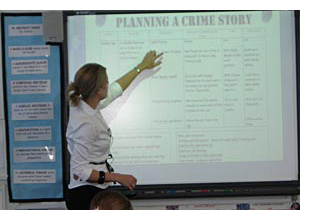English: Crime writing in middle school
Developing a dialogic approach to interactive whiteboard use in English

Teacher: Caroline Neale
Year level: Year 8 (aged 12-13)
School: Greneway Middle School, Royston, Hertfordshire, UK,
At the start of this project, I was a practitioner with 7 years experience, who had always placed great value on dialogue, both for academic and pastoral purposes, and who had also been using a SmartBoard on a daily, and very nearly lesson by lesson, basis. However, I had not previously considered how to exploit this classroom resource to explicitly support dialogue.
The following examples come from a sequence of lessons planned around the theme of crime writing. The aim of the lessons was to provide pupils with background information about features of the genre which they could then use in their own creative writing. (Click here to download a zipped folder "CN-Lesson-materials" of my lesson plans and materials, including my SMART Notebook flipcharts). There were three key areas of IWB use that I wished to explore. Firstly, I wanted to develop the multimodal opportunities of the board, for example, Flash interactive applications and the use of images, video clips and embedded sound files. All of these features are ones that seemed to help with maintaining pupils’ engagement and motivation, as well as stimulating discussion.  The picture on the left is one I used at the end of a lesson about crime scenes. Pupils were asked to come and circle parts of the scene which they would want to investigate, explaining their reasons to the rest of the group as they did this. The dialogue around the picture then built collectively as different pupils added their views. (It also served as a handy reminder as to the dangers of forgetting homework!)
The picture on the left is one I used at the end of a lesson about crime scenes. Pupils were asked to come and circle parts of the scene which they would want to investigate, explaining their reasons to the rest of the group as they did this. The dialogue around the picture then built collectively as different pupils added their views. (It also served as a handy reminder as to the dangers of forgetting homework!)
A second area I developed was greater use of the ‘interactive’ features of the board such as the ‘Badge of Truth’. As shown in the picture below, the IWB displayed a number of True/False statements relating to a real life crime story read in class. Pupils had to select whether the statement was true or false, giving clear reasons for their choice. They then moved the statement to the badge in the centre. Prior formatting in the software meant that if the statement was true it remained visible, if it was false, it magically disappeared!
The third area of focus was the way in which the IWB could be used to support pupils with what we termed ‘talk tasks’ in pairs or groups. Just as prompts or sentence starters can be given to pupils for writing tasks, so too can they be used for verbal activities. For example, when questioning each other about their work so far, pupils were able to use a variety of questions displayed on the IWB, to help extend their partners’ thinking, and lead to the subsequent improvement of their work.

On reflection, none of the activities devised were technologically complicated, but for me, this is just one of the benefits of the IWB - the simplest of uses can be extremely effective. The key points which emerged from a teaching perspective were that the IWB certainly supported pupil engagement and motivation and aided me in terms of both lesson preparation and flexibility during lessons. Its ability to allow for cumulative working is also a real strength. In a follow-up questionnaire, the majority of pupils involved in the project stated that they valued both the IWB and dialogue as tools to enhance learning - and as this is surely at the heart of all we do as teachers, it is this which I feel makes this approach an important one within my teaching repertoire.
